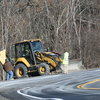Cell tower debated at Westerlo hearing
WESTERLO — Both sides at Tuesday’s public hearing spoke about the potential impact of a new cell tower off of Route 405, and whether it would be an eyesore or be a much-needed improvement for cell service.
Westerlo’s planning board held two public hearings Tuesday night. One was for was for Tarpon Towers II, on behalf of Cellco (doing business as Verizon Wireless) for an application for a special-use permit to build a wireless telecommunications tower off of County Route 405. The other hearing, for a solar farm, involved no public outcry and the permit was approved.
The tower would be 120 feet high and 2.1 miles from another tower in South Westerlo, just under the minimum distance of 2.5 miles required between cell towers according to the town’s zoning laws, but the law also states that an exception can be made should no other location be able to provide adequate coverage. Radio-frequency engineer Rick Andris, who has been contracted by Verizon, said that the the tower needed to be located at the highest elevation in the area in order for the signal to reach users, which is why the proposed spot was chosen.
Dorothy Verch, who chairs the planning board, has told the town board at a previous meeting that the current tower would need to be increased to 300 feet in height in order to render the service that the proposed tower would render.
The service from the proposed tower is expected to reach users within 2.5 miles, touching parts of Greenville, South Westerlo, Westerlo, and Medusa.
Speaking at the public hearing, Lorraine Pecylak presented 127 signatures on a petition against construction of the tower. She also presented signed letters that argued against another cell tower in Westerlo, and read aloud from the letter.
Pecylak, a South Westerlo resident, is concerned about the visual impact, citing zoning laws that she said the town had designed to protect scenic views. She pondered the potential visual impact at the Restifo Sanctuary, a 51-acre preserve owned by the Mohawk Hudson Land Conservancy off of Maple Avenue Extension in Westerlo. She told The Enterprise that there are also about 84 acres of privately owned wetlands nearby.
The tower was first proposed in Tarpon’s application in October 2016. Visibility tests to find out if concerns like Pecylak’s are valid have ended up in sticky situations. A balloon test in November was unsuccessful due to high winds. It was later found out that this test was against town law to do.
In March, a test involving a hydraulic lift was delayed by two days, first due to a mix-up in schedules, and then again when the vehicle attached to the lift became stuck and had to be dug out by a local contractor.
High in the sky: The March crane test was meant to convey the visual impact of a proposed 120-foot cell tower in Westerlo. Some residents are concerned that the tower could obstruct scenic views in the town as well as be a health risk.
At the meeting, Pecylak contended that, because the test occurred not on the advertised date of March 21, but on March 23, that there was not proper notification of the visual test. Verch responded that she had contacted her fellow board members, who are the ones required to be notified, and that Verizon had attempted to contact the adjoining property owners. Verch read off a list of residents contacted, including some with disconnected phone lines, or numbers from out of the area.
“Even if everyone was notified, not everyone did see it,” said an audience member.
The board also presented pictures of the crane test, which some in the audience still objected to, saying it would be necessary to be present at the time of the test to see what it was really like.
Pecylak told The Enterprise a few weeks ago that her main objection to the tower is the potential health risks from radio-frequency radiation, but noted that that environmental risks can not be a reason that a cell tower is denied a permit. A 1996 Federal Communications Commission law states that governing bodies cannot regulate wireless service facilities “on the basis of the environmental effects of radio frequency emissions to the extent that such facilities comply with the Commission's regulations concerning such emissions.”
A 1993 New York State Appellate Court decision found that cellular service is considered a public utility.
Andris said that the tower is tested for emissions three times a year and never goes beyond FCC regulations, saying the equipment at the tower does not even the capacity to do so.
Joseph Tharian, of Scotia, who came with Pecylak, spoke at the hearing and asked the board and the residents to be cautious of RF emissions, saying that it once was acceptable to dump PCBs, or polychlorinated biphenyls, in the Hudson River when it was later found out to be harmful.
The American Cancer Society states that the energy level of RF waves is too low and the wavelengths too short to affect individual cells in the body; at ground-level, there is also a very low presence of RF waves. Research is still ongoing to find out if there is in fact a connection between cancer and proximity to a cell tower.
Barbara Valentine, who lives about four miles away from the cell tower, compared concerns about RF radiation to previous concerns about eating eggs, now widely dismissed. Valentine described her cell service as “on a scale from 1 to 10, ten being the best, I’m below 1,” and said that if it did not work out for the cell tower at the proposed location, “I have 1100 acres.”
Verch said the lack of cell service as well as broadband internet has become a detriment to the town’s youth. She described students sitting outside the Westerlo Library’s steps after hours in order to use the free wifi to complete their homework assignments online or do online research. Verch said this puts these students who attend Berne-Knox-Westerlo at a disadvantage to students from Berne and Knox, who might have better internet or phone service.
Westerlo Councilman Joseph Boone, speaking from the gallery, asked if the board knew how many people in the area used solely cell phones versus having a landline at home, saying it seemed to him to be a growing trend to give up or never use a landline.
The planning board decided to schedule the completion of the environmental impact study (one part has been conducted by Verizon, the other must be completed by the board, said Verch) by May 23, when the next planning board meeting will be held at 7 p.m.
Solar farm
The planning board also held a public hearing for an application for a special use permit by Beller Solar Farm to establish a community solar farm Loren Dee Drive.
Stuart J. Beller said his company is looking to establish a community solar farm, likely with Viking Solar, but said that decision would be tabled until the planning board had approved the project.
A man in the gallery who said his property abutted the solar farm had not been notified, but said he did not object to a solar farm. Beller said the neighboring landowners had been notified based on who had been contacted when an application for subdivision at the same location had been submitted.
The board voted to approve the application, with member Gerald Boone abstaining.


